NCERT Solutions for Exercise 6.3 Class 9 Maths Chapter 6 - Lines and Angles
NCERT Solutions for Class 9 Maths Chapter 6 Lines and Angles Ex 6.3- Download Free PDF
NCERT Solutions Class 9 Maths Chapter 6 Exercise 6.3 Lines and Angles- We'll explore the creation of lines and angles in 9th class maths exercise 6.3 answers of NCERT Solutions. This chapter explains how lines and angles interact and teaches us key rules and theorems. We may improve our problem-solving skills and see how lines and angles are utilised in maths and in the real world by undertaking the tasks in this chapter.
The class 9 maths chapter 6 exercise 6.3 have been carefully crafted by subject experts using simple language and clear explanations. There are a total of six questions that cover important concepts related to lines and angles. Additionally, students have the option to download the PDF version of these exercise 6.3 class 9 mathssolution for offline use, all without any cost. These resources are designed to make learning easier and more accessible for students, Along with NCERT book Class 9 Maths, chapter 6 exercise 6.3 the following exercises are also present.
NCERT Solutions Class 9 Maths Chapter 6 Exercise 6.3 Lines and Angles
Access Lines and Angles Class 9 Maths Chapter 6 Exercise: 6.3
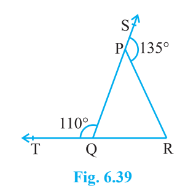
Answer:

![]()
Given,
PQR is a triangle, $\angle$ SPR = $135^0$ , $\angle$ PQT = $110^0$
Now, $\angle$ TQP + $\angle$ PQR = $180^0$ (Linear pair)
So, $\angle$ PQR = $180^0-110^0 = 70^0$
Since the side of QP of the triangle, PQR is produced to S
So, $\angle$ PQR + $\angle$ PRQ = $135^0$ (Exterior angle property of triangle)
$\therefore \angle PRQ = 135^0 - 70^0 = 65^0$
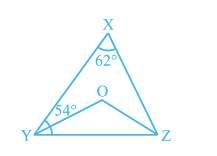
![]()
Answer:
We have
$\angle$ X = $62^0$ , $\angle$ XYZ = $54^0$
YO and ZO bisects the $\angle$ XYZ and $\angle$ XZY
Now, In $\Delta$ XYZ, by using angle sum property
$\angle$ XYZ + $\angle$ YZX + $\angle$ ZXY = $180^0$
So, $\angle$ YZX = $180^0-54^0-62^0$
$\angle$ YZX = $64^0$
and, $\angle$ OYZ = $54^0/2 = 27^0$ also, $\angle$ OZY = $32^0$
Now, in $\Delta$ OYZ
$\angle$ Y + $\angle$ O + $\angle$ Z = $180^0$ [ $\angle$ Y = $32^0$ and $\angle$ Z = $64^0$ ]
So, $\angle$ YOZ = $121^0$
Q3 In Fig. 6.41, if AB $||$ DE, $\angle$ BAC = 35° and $\angle$ CDE = 53°, find $\angle$ DCE.
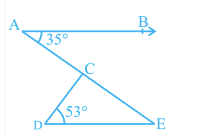
![]()
Answer:
We have,
AB || DE, $\angle$ BAC = 35° and $\angle$ CDE = 53°
AE is a transversal so, $\angle$ BAC = $\angle$ AED = $35^0$
Now, In $\Delta$ CDE,
$\angle$ CDE + $\angle$ DEC + $\angle$ ECD = $180^0$ (By angle sum property)
Therefore, $\angle$ ECD = $180^0-53^0-35^0$
$\angle ECD = 92^0$
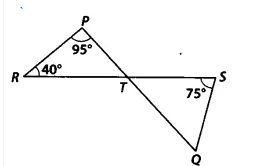
![]()
Answer:
We have,
lines PQ and RS intersect at point T, such that $\angle$ PRT = 40°, $\angle$ RPT = 95° and $\angle$ TSQ = 75°
In $\Delta$ PRT, by using angle sum property
$\angle$ PRT + $\angle$ PTR + $\angle$ TPR = $180^0$
So, $\angle$ PTR = $180^0 -95^0-40^0$
$\Rightarrow \angle PTR = 45^0$
Since lines, PQ and RS intersect at point T
therefore, $\angle$ PTR = $\angle$ QTS (Vertically opposite angles)
$\angle$ QTS = $45^0$
Now, in $\Delta$ QTS,
By using angle sum property
$\angle$ TSQ + $\angle$ STQ + $\angle$ SQT = $180^0$
So, $\angle$ SQT = $180^0-45^0-75^0$
$\therefore \angle SQT = 60^0$

![]()
Answer:
We have,
PQ $\bot$ PS, PQ || SR, $\angle$ SQR = 28° and $\angle$ QRT = 65°
Now, In $\Delta$ QRS, the side SR produced to T and PQ || RS
therefore, $\angle$ QRT = $28^0+x$ = $65^0$
So, $x = 37^0$
Also, $\angle$ QRT = $\angle$ RSQ + $\angle$ SQR (By exterior angle property of a triangle)
Therefore, $\angle$ RSQ = $\angle$ QRT - $\angle$ SQR
$\angle RSQ = 65^0-28^0 = 37^0$
Now, in $\Delta$ PQS,
$\angle$ P + $\angle$ PQS + $\angle$ PSQ = $180^0$
$y=180^0-90^0-37^0$
$y=52^0$
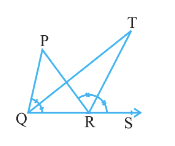
![]()
Answer:
We have,
$\Delta$ PQR is produced to a point S and bisectors of $\angle$ PQR and $\angle$ PRS meet at point T,
By exterior angle sum property,
$\angle$ PRS = $\angle$ P + $\angle$ PQR
Now, $\frac{1}{2}\angle PRS =\frac{1}{2}\angle P + \frac{1}{2} \angle PQR$
$\Rightarrow \angle TRS = \frac{1}{2}\angle P + \angle TQR$ ................(i)
Since QT and QR are the bisectors of $\angle$ PQR and $\angle$ PRS respectively.
Now, in $\Delta$ QRT,
$\angle TRS = \angle T + \angle TQR$ ..............(ii)
From eq (i) and eq (ii), we get
$\frac{1}{2}\angle P= \angle T$
$\Rightarrow \frac{1}{2}\angle QPR= \angle QTR$
Hence proved.
The angle sum property in triangles is proved using the theorems and axioms of parallel lines in NCERT Solutions for Class 9 Maths chapter 6 exercise 6.3 Lines and Angles. The triangle angle sum property states that the sum of a triangle's angles is 180 degrees.
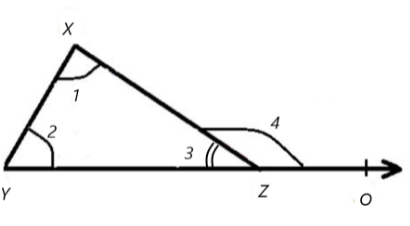
If a triangle side is formed, the exterior angle formed is equal to the sum of the two interior opposite angles. i.e. An exterior angle of a triangle = sum of opposite internal angles.
We can also prove this theorem very easily just by equating two equations.
We know that the sum of all interior angles of triangles is 180. So, from the above figure.
![]() (1)
(1)
And we also know that the angle of a straight line is 180.
![]() (2)
(2)
We will now equate equations 1 and 2 because the right-hand side of both equations is 180.
Hence,
![]()
We subtract angle 3 from both sides. So,
![]()
Hence, the exterior angle is equal to the sum of two opposite interior angles.
If a triangle side is formed, the exterior angle formed is equal to the sum of the two interior opposite angles.
More About NCERT Solutions for Class 9 Maths Exercise 6.3
Intersecting lines are lines that cross each other from a specific point. Non-intersecting Lines are lines that never cross each other at any point. These are known as Parallel Lines, and the distance between parallel lines is the common length between two lines.
When a line passes through two distinct lines and intersects them at different points, this line is referred to as a transversal line.
Complementary angles are those whose sum of two angles equals 90°.
Supplementary angles are those whose sum of two angles equals 180°.
Also Read| Lines And Angles Class 9 Notes
Benefits of NCERT Solutions for Class 9 Maths Exercise 6.3
- From NCERT syllabus Class 9 Maths chapter 6 exercise 6.3 we learn new formulas to calculate the mean and class mark.
- Exercise 6.3 Class 9 Maths, is based on the angle sum property of a triangle
- Understanding the concepts from Class 9 Maths chapter 6 exercise 6.3 will allow us to understand the concepts related to higher standard questions related to angle sum property of a triangle
Key Features of Class 9 Maths Chapter 6 Exercise 6.3
Comprehensive Coverage: The exercise 6.3 class 9 maths covers various concepts related to lines and angles, ensuring a thorough understanding of this fundamental geometry topic.
Expert-Crafted Solutions: The class 9 maths ex 6.3 solutions provided are written by subject experts, offering clear and concise explanations to help students grasp the concepts easily.
Easy-to-Understand Language: The 9th class maths exercise 6.3 answers are presented in simple and easy-to-understand language, making it accessible to students of all levels.
Variety of Questions: The class 9 ex 6.3 consists of a total of six questions, offering a variety of problem types to test students' understanding and problem-solving skills.
Conceptual Clarity: By solving these ex 6.3 class 9 questions, students can gain a deeper understanding of the relationships between lines and angles, helping them build a strong foundation in geometry.
Offline Accessibility: Students have the option to download the PDF version of the solutions, allowing them to access and use the resources offline without any additional cost.
Also, See
NCERT Solutions of Class 10 Subject Wise
Subject Wise NCERT Exemplar Solutions
Frequently Asked Questions (FAQs)
This exercise is about the Angle Sum Property of a triangle, types of angles like vertically opposite angles and axioms.
A triangle is a closed geometric object with three sides and three angles that has three sides and three angles.
The sum of a triangle's angles is 180.
The sum of a triangle's two inner opposite angles equals the triangle's outer angle.
Since the sum of all the angles of a triangle is 180
And the rest two angles are 120 and 20
The third angle is 180-140=40
No, we can’t make a triangle with two angles as 110° and 90°. Because the sum exceeds 180
The angles are 15°, 60° and 105°
Popular Questions
Courses After 12th
Applications for Admissions are open.
As per latest syllabus. Physics formulas, equations, & laws of class 11 & 12th chapters
JEE Main Important Chemistry formulas
Get nowAs per latest syllabus. Chemistry formulas, equations, & laws of class 11 & 12th chapters
JEE Main high scoring chapters and topics
Get nowAs per latest 2024 syllabus. Study 40% syllabus and score upto 100% marks in JEE
JEE Main Important Mathematics Formulas
Get nowAs per latest syllabus. Maths formulas, equations, & theorems of class 11 & 12th chapters
